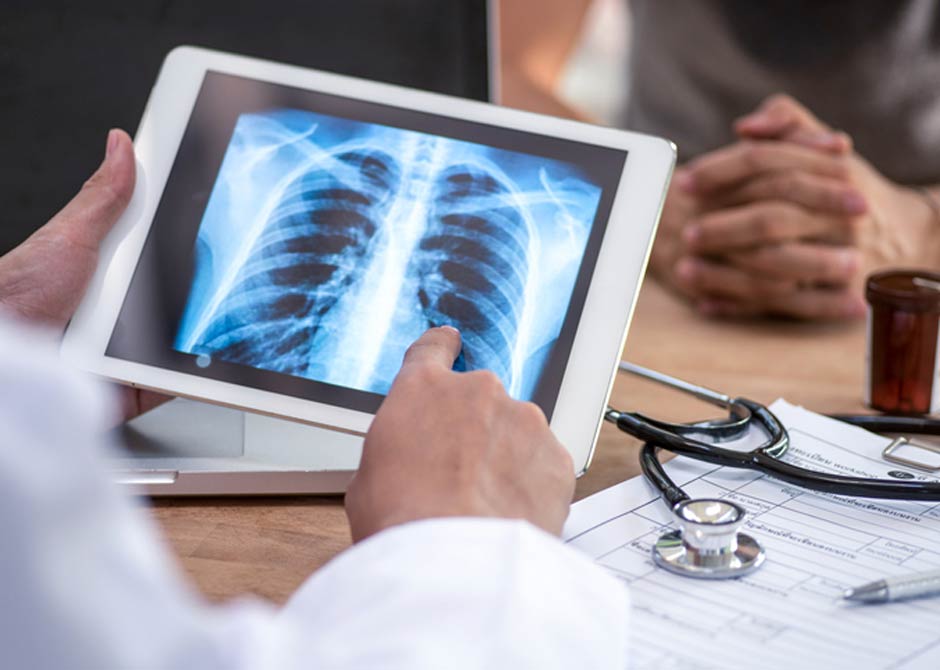 What is a lung nodule?
What is a lung nodule?
A lung nodule, also called a pulmonary lung nodule or pulmonary nodule, is an abnormal spot or small growth on the lung — typically less than 3 centimeters in size. Lung nodules are often detected incidentally on a chest X-ray or a computed tomography (CT) scan. Imaging tests of the chest and lungs may be done for a variety of reasons including to check for infection, injury or a blockage, or to screen for lung cancer.
Potential causes for lung nodules include:
- Congenital lung abnormalities
- Old infections resulting in scar tissue
- Noncancerous cysts
- The occurrence of a lung abscess
- Birth defects, such as lung malformation, scars or cysts in the lungs
- Inflammation caused by sarcoidosis, rheumatoid arthritis or Wegener’s granulomatosis (granulomatosis with polyangiitis ([GPA])
- Infection caused by human papilloma virus (HPV)
Nationwide, approximately 1.2 million lung nodules are detected each year. In most cases, lung nodules are not harmful. Most lung nodules are not cancerous and are caused by past lung infections; however, some may be cancerous. Proper testing, assessment and ongoing follow-up are necessary to accurately diagnose the type of lung nodule you have.
There are some risk factors associated with developing lung nodules. These risk factors may be environmental, behavioral or genetic and include:
Behavioral
- Current use or past use of tobacco products
Genetic
- Family or personal history of lung cancer
- Age 50 years of age or older
- History of previous cancer, not limited to the lungs
- Other types of lung disease, including pulmonary fibrosis and chronic obstructive pulmonary disease (COPD)
Environmental
- Receiving radiation therapy in the past
- Exposure to toxic chemicals, secondhand smoke, radon or asbestos
What you should know about lung nodules
Jasleen Pannu, MD, interventional pulmonologist, explains the treatment available for lung nodules at The Ohio State University Wexner Medical Center Lung Nodule Clinic.
Lung nodules signs and symptoms
Signs and symptoms of lung nodules can vary based on the exact location, size and shape of the nodule in the lung. Small nodules found in the lungs are often incidentally or unexpectedly discovered following an X-ray or CT scan of the chest performed because of symptoms caused by other illnesses or infections.
Symptoms associated with lung nodules may also be caused by:
- COPD
- Pain or trauma to the chest
- Surgeries close to the chest, neck and shoulder
- COVID-19
Many of the symptoms associated with lung nodules are like those of the conditions listed above. Because of this, it’s important to monitor your symptoms closely and seek medical care if the symptoms persist. If you recently had COVID-19 or are recovering from an infection, the symptoms may last longer than other illnesses, such as a cold or flu.
However, if symptoms are noticeable, they may include:
- Chronic cough, potentially with blood present
- Shortness of breath, hoarseness or wheezing
- Respiratory infections
- Fatigue
- Chronic chest pain
Types of lung nodules
There are also several different types of noncancerous (benign) lung nodules including:
- Hamartomas: These are the most common type of lung nodules. Most are found in the outer section of the connective tissue of the lungs. A smaller percentage is found within the bronchial tubes.
- Papillomas: Papillomas are less common than other types of lung nodules, growing in the bronchial tubes. This category is typically separated into three types: mixed squamous and glandular, glandular, and squamous.
- Bronchial adenomas: These lung nodules grow in the mucous glands or ducts within the windpipe and in the bronchi (large airways of the lungs).
If a lung nodule is suspected to potentially be cancerous, your provider will recommend additional screenings for further evaluation.
Screening and diagnosis of lung nodules
If the presence of a lung nodule is suspected for any reason, an early diagnosis is a key contributor to successful treatment outcomes. Your doctor will do a comprehensive history and physical exam and discuss your overall health and signs of disease, as well as your habits, past illnesses and treatments.
- After the initial exam — depending on your symptoms — your doctor may suggest additional diagnostic or screening tests to determine the cause of your symptoms. This phase of testing or screening will vary greatly — depending on the size of the nodule — and may include:
- Chest X-ray
- CT scan
- PET scan
- Biopsy
- Lung function testing
- Surgery
- Bronchoscopy
Lung nodule treatment
Depending on your specific lung nodule, the lung nodule clinic treatment team may recommend one or a combination of the following interventions:
- Watchful waiting – close follow-up of a patient’s condition by repeat imaging unless symptoms arise or any change is noted in follow-up imaging
- Robotic bronchoscopy and biopsy – a minimally invasive procedure that enables the physician to examine the inside of the trachea, bronchi (air passages that lead to the lungs) and lungs without an incision
- Biopsy – enables a physician to remove cells or tissues for examination by a pathologist. The pathologist may study the tissue under a microscope or recommend performing other tests
In the event your provider determines you should receive further diagnostic imaging or treatment for your lung nodules, you may be referred to the OSUCCC – James Lung Nodule Screening Clinic.


